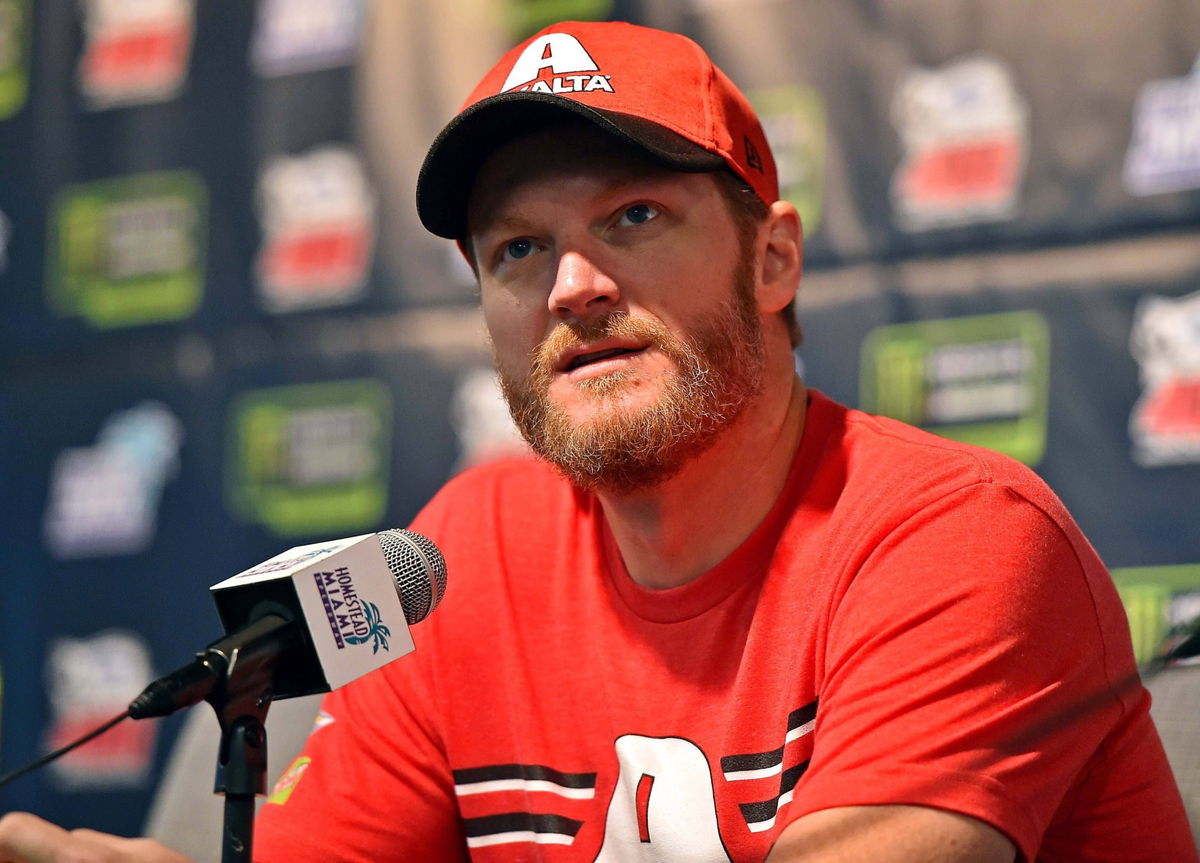

Sometimes, the racing community’s demands can be a bit unrealistic, whether they’re calling for the elimination of short tracks or pushing for longer weekly recaps. After the Cup Series race at New Hampshire Motor Speedway (NHMS), one hot topic has been the push to keep races going despite wet weather conditions.
Watch What’s Trending Now!
As fans, it’s natural to want your money’s worth, and that’s not unreasonable. Many now see Goodyear’s wet weather tires as a beacon of hope. But this isn’t the first time NASCAR has introduced these tires; they made an appearance earlier this season at Richmond. Despite their promise, wet weather tires have limitations, and racing in the rain brings its own risks. Dale Earnhardt Jr made this clear in a recent episode of his podcast, “Dale Jr. Download.”
ADVERTISEMENT
Dale Jr’s take on what happened in Loudon
NASCAR’s choice to use wet weather tires after the rain-delayed restart at NHMS proved to be a brilliant move. In a nutshell, fans were able to enjoy the full 301 laps, teams were content, and some drivers—particularly those with dirt racing experience—had a great time.
It brought back memories of Bristol, where tire management was crucial. In the past, Goodyear has faced criticism for its last-minute strategies, but this time they were the heroes. Without these tires, the race would have been called off with 82 laps remaining, declaring Tyler Reddick the winner instead of Christopher Bell.
Finally, one can say that NASCAR has fully entered the wet-weather tire era, even officials deem that the race in Loudon was a great success. “I think the way we started this whole wet-weather-tire-process was basically we wanted to get our races started on time. And it really played into our hand yesterday to get the Xfinity race started on time and to get our races back to green as quick as possible if we’ve had a delay, which we had today, so you know, kudos to Goodyear,” said Elton Sawyer, NASCAR SVP of Competition.
ADVERTISEMENT
However, Dale Jr always takes the fans’ side, as he believes what viewers consume is half-baked. And, tackling their high expectations Dale Jr in his podcast on June 26th, mentioned, “The Cup race this weekend, the whole conversation is going to be about the tires—the rain tires, wet weather tires. There’s a bit of a disconnect between what NASCAR knows about the tire and its capabilities, and what the fan at home knows. NASCAR needs to make clear why the tire is there, what it will be used for, and what it won’t be used for.” This disconnect fuels fans’ unrealistic demands, expecting these tires to perform miracles in heavy rain.
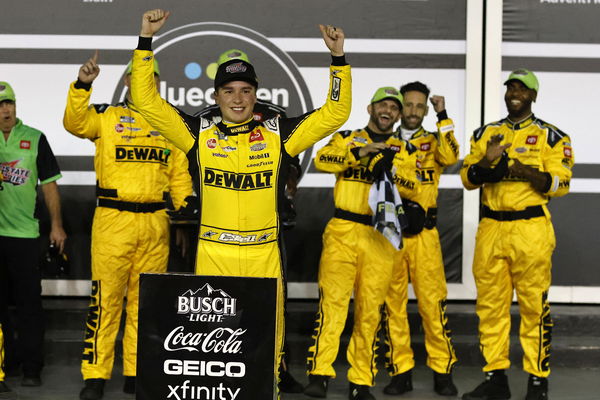
USA Today via Reuters
Feb 15, 2024; Daytona Beach, Florida, USA; NASCAR Cup Series driver Christopher Bell (20) reacts in victory lane after winning the Bluegreen Vacations Duel 2 at Daytona International Speedway. Mandatory Credit: Peter Casey-USA TODAY Sports
He continued, “NASCAR doesn’t want to be in a position of controlling the race so tightly. They want to turn it over to the teams, but they can’t risk a disaster. If they turn it over and things go wrong, everyone will blame NASCAR, not the teams.”
ADVERTISEMENT
His insights highlight the fine line NASCAR walks in balancing fan expectations and practical safety concerns. Whereas Junior emphasized that there’s a disconnect between what NASCAR knows about the tire’s capabilities and what fans understand about them. He suggests that before races, NASCAR should clearly explain the purpose and use of the tires, particularly in bad weather. While NASCAR aims to let teams handle racing decisions in all conditions, there’s hesitation because if something goes wrong, fans will blame NASCAR. He emphasizes the need for better communication to align fans’ expectations with NASCAR’s goals.
On the other hand, it was Dalton who highlighted the nature of tires, saying, “Rain tires are tricky. When you hear rain tires, you think, ‘Oh, they can race in the rain. No problem.’ But it’s not that simple.” And, guess what? Dale Jr agreed, “Wet weather tires make more sense. The name itself sets better expectations.” This clarification is crucial to managing fans’ expectations and understanding the real capabilities of these tires. That being said, what are its thoughts on wet tires?
ADVERTISEMENT
Top Stories
Dale Jr. Warns of Deeper Issues as Joe Gibbs Parts Ways With Decade-Long Executive

Chase Elliott’s Popularity Hits New Low as Dale Jr.’s Daytona 500 Return Triggers Record-Breaking Sale
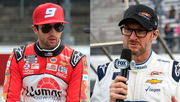
Richard Childress & Johnny Morris Make Patriotic Power Moves Days After Causing NASCAR’s Collapse in Courtroom

“Shouldn’t Keep His Job”: Dale Earnhardt’s Long-Time Sponsor Demands Steve Phelps’ Ouster After Disgracing Richard Childress
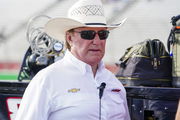
NASCAR Distances Themselves From Commissioner Steve Phelps After Public Embarrassment Claims Insider
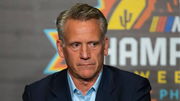
NASCAR’s clear stability on wet weather tires
NASCAR’s VP of Competition, Elton Sawyer, made it clear that wet-weather tires aren’t meant for racing in the rain but for damp conditions. “We just want to do this in the safest way possible,” Sawyer said. During the NHMS race, NASCAR opted for non-competitive pit stops to ensure safety. This decision, while controversial, did offer fans something to cheer about.
Sawyer elaborated on the rationale behind these tires, stating, “If you look at the reason we came up with this and started working with teams and the folks at the R&D center, it was to do exactly what we did yesterday with the Xfinity race and what we did today with the Cup race. So yes, very successful.” It wasn’t just Sawyer who was full of praise; that would have been too egoistic. Other veterans, like Adam Stevens and Joe Gibbs, were full of praise.
ADVERTISEMENT

Imago
Teilnehmerfeld der Daytona 500, v.li.: Martin Truex Jr., Tony Stewart, Kurt Busch, Jimmie Johnson, David Ragan, Dale Earnhardt Jr., Clint Bowyer, Carl Edwards, Brian Vickers und David Stremme – (ZUMAse4)
Stevens, initially a skeptic, admitted, “I thought they were crazy. They proved me wrong. They did a really good job of coming up with a plan methodically.” He further adds, “They figured out that once you got the water off the race track, you could run in it. That was probably the best way to dry the track, too.” The racing community has a lot to take away from these words of wisdom.”
In NASCAR, hopes and sentiments often give rise to unrealistic expectations. Next time someone argues against wet weather tires, point them to the success at NHMS.
ADVERTISEMENT
ADVERTISEMENT
ADVERTISEMENT
ADVERTISEMENT

